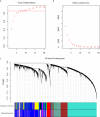PSMB7 Is a Key Gene Involved in the Development of Multiple Myeloma and Resistance to Bortezomib
- PMID: 34367968
- PMCID: PMC8343178
- DOI: 10.3389/fonc.2021.684232
PSMB7 Is a Key Gene Involved in the Development of Multiple Myeloma and Resistance to Bortezomib
Abstract
Multiple myeloma (MM), the second most commonly diagnosed hematologic neoplasm, is the most significant clinical manifestation in a series of plasma cell (PC) dyscrasia. Monoclonal gammopathy of undetermined significance (MGUS) and smoldering MM (SMM), approximately 1% or 10% of which, respectively, can progress to MM per year, are the premalignant stages of MM. The overall survival (OS) of MM is significantly improved by the introduction of proteasome inhibitors (PIs), but almost all MM patients eventually relapse and resist anti-MM drugs. Therefore, it is crucial to explore the progression of MM and the mechanisms related to MM drug resistance. In this study, we used weighted gene co-expression network analysis (WGCNA) to analyze the gene expression of the dynamic process from normal plasma cells (NPC) to malignant profiling PC, and found that the abnormal gene expression was mainly concentrated in the proteasome. We also found that the expression of one of the proteasomal subunits PSMB7 was capable of distinguishing the different stages of PC dyscrasia and was the highest in ISS III. In the bortezomib (BTZ) treated NDMM patients, higher PSMB7 expression was associated with shorter survival time, and the expression of PSMB7 in the BTZ treatment group was significantly higher than in the thalidomide (Thai) treatment group. In summary, we found that PSMB7 is the key gene associated with MM disease progression and drug resistance.
Keywords: PSMB7; WGCNA; drug resistance; multiple myeloma; proteasome inhibitor.
Copyright © 2021 Wu, Miao, Hu, Li, Gao, Chen, Feng, Shen and He.
Conflict of interest statement
The authors declare that the research was conducted in the absence of any commercial or financial relationships that could be construed as a potential conflict of interest.
Figures







Similar articles
-
Increased circulating VCAM-1 correlates with advanced disease and poor survival in patients with multiple myeloma: reduction by post-bortezomib and lenalidomide treatment.Blood Cancer J. 2016 May 27;6(5):e428. doi: 10.1038/bcj.2016.37. Blood Cancer J. 2016. PMID: 27232930 Free PMC article.
-
Proteasome Subunits Differentially Control Myeloma Cell Viability and Proteasome Inhibitor Sensitivity.Mol Cancer Res. 2020 Oct;18(10):1453-1464. doi: 10.1158/1541-7786.MCR-19-1026. Epub 2020 Jun 19. Mol Cancer Res. 2020. PMID: 32561655 Free PMC article.
-
A contribution to examination of propidium iodide and annexin V plasma cells indices in multiple myeloma.Neoplasma. 2003;50(5):363-71. Neoplasma. 2003. PMID: 14628090
-
Changing paradigms in diagnosis and treatment of monoclonal gammopathy of undetermined significance (MGUS) and smoldering multiple myeloma (SMM).Leukemia. 2020 Dec;34(12):3111-3125. doi: 10.1038/s41375-020-01051-x. Epub 2020 Oct 12. Leukemia. 2020. PMID: 33046818 Review.
-
MGUS and Smoldering Multiple Myeloma: Diagnosis and Epidemiology.Cancer Treat Res. 2016;169:3-12. doi: 10.1007/978-3-319-40320-5_1. Cancer Treat Res. 2016. PMID: 27696254 Review.
Cited by
-
Exploring cellular diversity in lung adenocarcinoma epithelium: Advancing prognostic methods and immunotherapeutic strategies.Cell Prolif. 2024 Nov;57(11):e13703. doi: 10.1111/cpr.13703. Epub 2024 Jun 30. Cell Prolif. 2024. PMID: 38946232 Free PMC article.
-
Cross talk between tumor stemness and microenvironment for prognosis and immunotherapy of uveal melanoma.J Cancer Res Clin Oncol. 2023 Oct;149(13):11951-11968. doi: 10.1007/s00432-023-05061-x. Epub 2023 Jul 7. J Cancer Res Clin Oncol. 2023. PMID: 37420017 Free PMC article.
-
SNPs Give LACTB Oncogene-Like Functions and Prompt Tumor Progression via Dual-Regulating p53.Adv Sci (Weinh). 2024 Nov;11(43):e2405907. doi: 10.1002/advs.202405907. Epub 2024 Sep 26. Adv Sci (Weinh). 2024. PMID: 39324579 Free PMC article.
-
FNDC3B and BPGM Are Involved in Human Papillomavirus-Mediated Carcinogenesis of Cervical Cancer.Front Oncol. 2021 Dec 16;11:783868. doi: 10.3389/fonc.2021.783868. eCollection 2021. Front Oncol. 2021. PMID: 34976823 Free PMC article.
-
A method for the identification of lactate metabolism-related prognostic biomarkers and its validations in non-small cell lung cancer.Sci Rep. 2025 Feb 17;15(1):5812. doi: 10.1038/s41598-025-85620-z. Sci Rep. 2025. PMID: 39962075 Free PMC article.
References
-
- Perez-Persona E, Vidriales MB, Mateo G, García-Sanz R, Mateos M-V, García de Coca A, et al. . New Criteria to Identify Risk of Progression in Monoclonal Gammopathy of Uncertain Significance and Smoldering Multiple Myeloma Based on Multiparameter Flow Cytometry Analysis of Bone Marrow Plasma Cells. Blood (2007) 110(7):2586–92. 10.1182/blood-2007-05-088443 - DOI - PubMed
LinkOut - more resources
Full Text Sources
Miscellaneous

